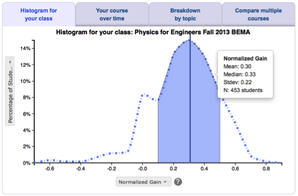
Developed by: Chandralekha Singh and PER team at the University of Pittsburgh




middle schoolhigh schoolintro collegeinter-mediateupper levelgrad school other






Overview
What? Worksheets, clicker questions, and homework for quantum mechanics including contemporary topics. Connect quantitative formalism to qualitative understanding and build physical intuition. Use visualization tools from Open Source Physics. Can be used in class, as homework, or as a self-study tool.
Why? They use visualization tools to help students build physical intuition about quantum processes. They keep students actively engaged in the learning process. They bridge the gap between abstract quantitative formalism and qualitative understanding. They can supplement your existing materials.
Why not? You might prefer to use different research-based materials designed for quantum mechanics courses, such as Paradigms in Physics or CU upper-division QM curriculum.
Student skills developed
- Conceptual understanding
- Making real-world connections
- Using multiple representations
- Metacognition
Instructor effort required
- Medium
Resources
Teaching Materials
You can download all the QuILTS for free from their PhysPort curriculum page.
Research
This is the third highest level of research validation, corresponding to:
- at least 1 of the "based on" categories
- at least 1 of the "demonstrated to improve" categories
- at least 1 of the "studied using" categories
Research Validation Summary
Based on Research Into:
- theories of how students learn
- student ideas about specific topics
Demonstrated to Improve:
- conceptual understanding
- problem-solving skills
- lab skills
- beliefs and attitudes
- attendance
- retention of students
- success of underrepresented groups
- performance in subsequent classes
Studied using:
- cycle of research and redevelopment
- student interviews
- classroom observations
- analysis of written work
- research at multiple institutions
- research by multiple groups
- peer-reviewed publication
References
- B. Brown, Developing and Assessing Research-Based Tools for Teaching Quantum Mechanics and Thermodynamics, University of Pittsburgh, 2015.
- B. Brown and C. Singh, Development and Evaluation of a Quantum Interactive Learning Tutorial on Larmor Precession Of Spin, presented at the Physics Education Research Conference 2014, Minneapolis, MN, 2014.
- S. DeVore, Using the Tutorial Approach to Improve Physics Learning from Introductory to Graduate Level, University of Pittsburgh, 2014.
- S. DeVore and C. Singh, Development of an Interactive Tutorial on Quantum Key Distribution, presented at the Physics Education Research Conference 2014, Minneapolis, MN, 2014.
- C. Keebaugh, Developing and Evaluating Research-Based Learning Tools for Quantum Mechanics, Dissertation, University of Pittsburgh, 2018.
- C. Keebaugh, E. Marshman, and C. Singh, Developing and evaluating an interactive tutorial on degenerate perturbation theory, presented at the Physics Education Research Conference 2016, Sacramento, CA, 2016.
- S. Lin and C. Singh, Categorization of quantum mechanics problems by professors and students, Eur. J. Phys. 31 (1), 57 (2010).
- E. Marshman, Improving the Quantum Mechanics Content Knowledge and Pedagogical Content Knowledge of Physics Graduate Students, University of Pittsburgh, 2015.
- E. Marshman and C. Singh, Developing an Interactive Tutorial on a Quantum Eraser, presented at the Physics Education Research Conference 2014, Minneapolis, MN, 2014.
- E. Marshman and C. Singh, Improving student understanding of Dirac notation by using analogical reasoning in the context of a three-dimensional vector space, presented at the Physics Education Research Conference 2020, Virtual Conference, 2020.
- A. Mason and C. Singh, Do advanced physics students learn from their mistakes without explicit intervention?, Am. J. Phys. 78 (7), 760 (2010).
- R. Sayer, A. Maries, and C. Singh, Developing and evaluating a tutorial on the double-slit experiment, presented at the Physics Education Research Conference 2015, College Park, MD, 2015.
- C. Singh, Student understanding of quantum mechanics, Am. J. Phys. 69 (8), 885 (2001).
- C. Singh, Helping Students Learn Quantum Mechanics for Quantum Computing, presented at the Physics Education Research Conference 2006, Syracuse, New York, 2006.
- C. Singh, Interactive Learning Tutorials on Quantum Mechanics, Am. J. Phys. 76 (4), 400 (2008).
- C. Singh, Student understanding of quantum mechanics at the beginning of graduate instruction, Am. J. Phys. 76 (3), 277 (2008).
- C. Singh, M. Belloni, and W. Christian, Improving Students' Understanding of Quantum Mechanics, Phys. Today 59 (8), 43 (2006).
- C. Singh and E. Marshman, Developing an interactive tutorial on a Mach-Zehnder Interferometer with single photons, presented at the Physics Education Research Conference 2014, Minneapolis, MN, 2014.
- C. Singh and G. Zhu, Students' understanding of the addition of angular momentum, presented at the Physics Education Research Conference 2011, Omaha, Nebraska, 2011.
- G. Zhu, Improving Students' Understanding of Quantum Mechanics, Ph.D., University of Pittsburgh, 2011.
- G. Zhu and C. Singh, Students’ Understanding of Stern Gerlach Experiment, presented at the Physics Education Research Conference 2009, Ann Arbor, Michigan, 2009.
- G. Zhu and C. Singh, Improving Students’ Understanding of Quantum Measurement, presented at the Physics Education Research Conference 2010, Portland, Oregon, 2010.
- G. Zhu and C. Singh, Improving students' understanding of quantum mechanics via the Stern–Gerlach experiment, Am. J. Phys. 79 (5), 499 (2011).
- G. Zhu and C. Singh, Improving students’ understanding of quantum measurement. II. Development of research-based learning tools, Phys. Rev. ST Phys. Educ. Res. 8 (1), 010118 (2012).
- G. Zhu and C. Singh, Improving students’ understanding of quantum measurement. I. Investigation of difficulties, Phys. Rev. ST Phys. Educ. Res. 8 (1), 010117 (2012).
- G. Zhu and C. Singh, Improving student understanding of addition of angular momentum in quantum mechanics, Phys. Rev. ST Phys. Educ. Res. 9 (1), 010101 (2013).





